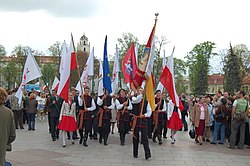
Back Поляци в Литва Bulgarian Polonesos de Lituània Catalan Polnische Minderheit in Litauen German Liettuan puolalaiset Finnish Polonais en Lituanie French 폴란드계 리투아니아인 Korean Lietuvos lenkai Lithuanian Lietuvas poļi Latvian/Lettish Poolse minderheid in Litouwen Dutch Polacy na Litwie Polish
This article may be too long to read and navigate comfortably. (April 2022) |
 Polish minority marching in Vilnius (2008) | |
| Total population | |
|---|---|
| 183,000 (2021 census)[1] | |
| Regions with significant populations | |
| Vilnius County | |
| Languages | |
| Polish, Lithuanian, Russian, Belarusian | |
| Religion | |
| Predominantly Roman Catholic[2] | |
| Related ethnic groups | |
| Poles, Lithuanians, Belarusians |
The Poles in Lithuania (Polish: Polacy na Litwie, Lithuanian: Lietuvos lenkai), also called Lithuanian Poles,[3][4] estimated at 183,000 people in the Lithuanian census of 2021 or 6.5% of Lithuania's total population, are the country's largest ethnic minority.
During the Polish–Lithuanian union, there was an influx of Poles into the Grand Duchy of Lithuania and the gradual Polonization of its elite and upper classes. At the end of the Polish–Lithuanian Commonwealth in 1795, almost all of Lithuania's nobility, clergy, and townspeople spoke Polish and adopted Polish culture, while still maintaining a Lithuanian identity.[5] In the 19th century, the processes of Polonization also affected Lithuanian and Belarusian peasants and led to the formation of a long strip of land with a predominantly Polish population, stretching to Daugavpils and including Vilnius. The rise of the Lithuanian national movement led to conflicts between both groups. Following World War I and the rebirth of both states, there was the Polish–Lithuanian War, whose main focus was Vilnius and the nearby region. In its aftermath, the majority of the Polish population living in the Lithuanian lands found themselves within the Polish borders. However, interwar Lithuania still retained a large Polish minority. During World War II, the Polish population was persecuted by the USSR and Nazi Germany. Post-World War II, the borders were changed, territorial disputes were suppressed as the Soviet Union exercised power over both countries and a significant part of the Polish population, especially the best-educated, was forcefully transferred from the Lithuanian SSR to the Polish People's Republic. At the same time, a significant number of Poles relocated from nearby regions of Byelorussian SSR to Vilnius and Vilnius region. After Lithuania regained independence, Lithuania–Poland relations were tense in the 1990s due to alleged discrimination of the Polish minority in Lithuania.[6][7][8][9][10]
Currently, the Polish population is grouped in the Vilnius region, primarily the Vilnius and Šalčininkai districts. In the city of Vilnius alone there are more than 85,000 Poles, who make up about 15% of the Lithuanian capital's population. Most Poles in Lithuania are Roman Catholic and speak Polish, although a minority of them speak Russian or Lithuanian, as their first language. Together with Vilnius City, Poles inhabit an area of approximately 4000 km2.
- ^ "Tautinių mažumų departamentas prie Lietuvos Respublikos Vyriausybės".
- ^ "Population by religious community to which they attributed themselves and ethnicity". Department of Statistics (Lithuania). Retrieved 2015-11-10.
- ^ Weeks, Theodore R. (2015-12-04). Vilnius between Nations, 1795–2000. Cornell University Press. p. 230. ISBN 978-1-5017-5808-9.
- ^ Wade, Peter (2007). Race, Ethnicity and Nation: Perspectives from Kinship and Genetics. Berghahn Books. p. 152. ISBN 978-1-84545-355-8.
- ^ Stone, Daniel Z. (2014-07-01). The Polish-Lithuanian State, 1386–1795. University of Washington Press. p. 63. ISBN 978-0-295-80362-3.
- ^ Evaldas Nekrasas. "Is Lithuania a Northern or Central European Country?" (PDF). Lithuanian Foreign Policy Review. p. 5. Archived from the original (PDF) on 2009-02-25. Retrieved 2008-03-30.
In a letter written to Vytautas Landsbergis in December of 1991, Polish President Lech Walesa described Lithuanian-Polish relations as "close to critical."
- ^ Antanas Valionis; Evaldas Ignatavičius; Izolda Bričkovskienė. "From Solidarity to Partnership: Lithuanian-Polish Relations 1988–1998" (PDF). Lithuanian Foreign Policy Review, 1998, issue 2. Archived from the original (PDF) on February 25, 2009. Retrieved 2008-03-29.
The interval between the restoration of diplomatic relations in September 1991 and the signing of the Treaty on Friendly Relations and Good Neighborly Cooperation on April 26, 1994 was probably the most difficult period for Lithuanian-Polish relations (there were even assertions that relations in this period were "in some ways even worse than before the war").
- ^ Stephen R. Burant and Voytek Zubek, Eastern Europe's Old Memories and New Realities: Resurrecting the Polish–Lithuanian Union, East European Politics and Societies 1993; 7; 370, online Archived 2020-05-24 at the Wayback Machine (BEHIND A PAYWALL)
- ^ Sanford 1999, p. 99.
- ^ Lane 2001, p. 209.
© MMXXIII Rich X Search. We shall prevail. All rights reserved. Rich X Search